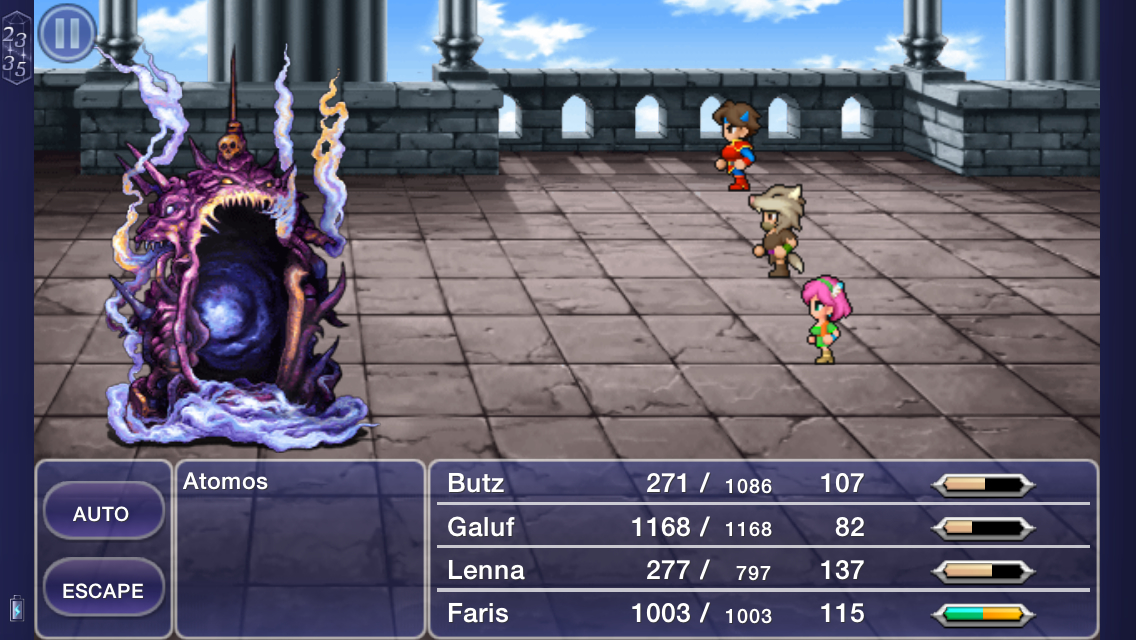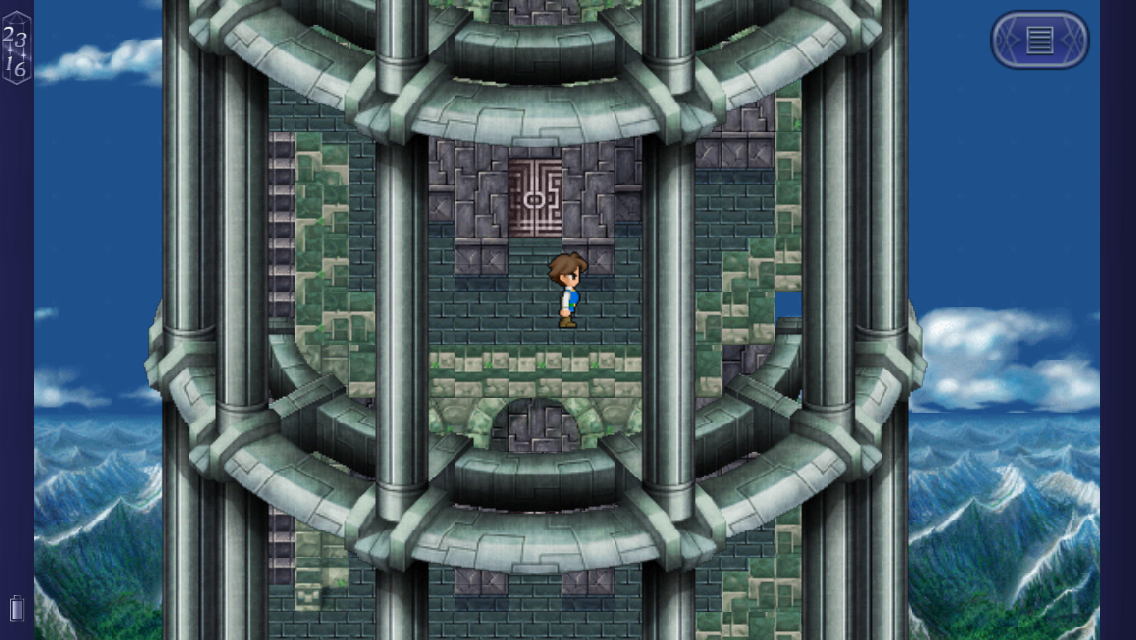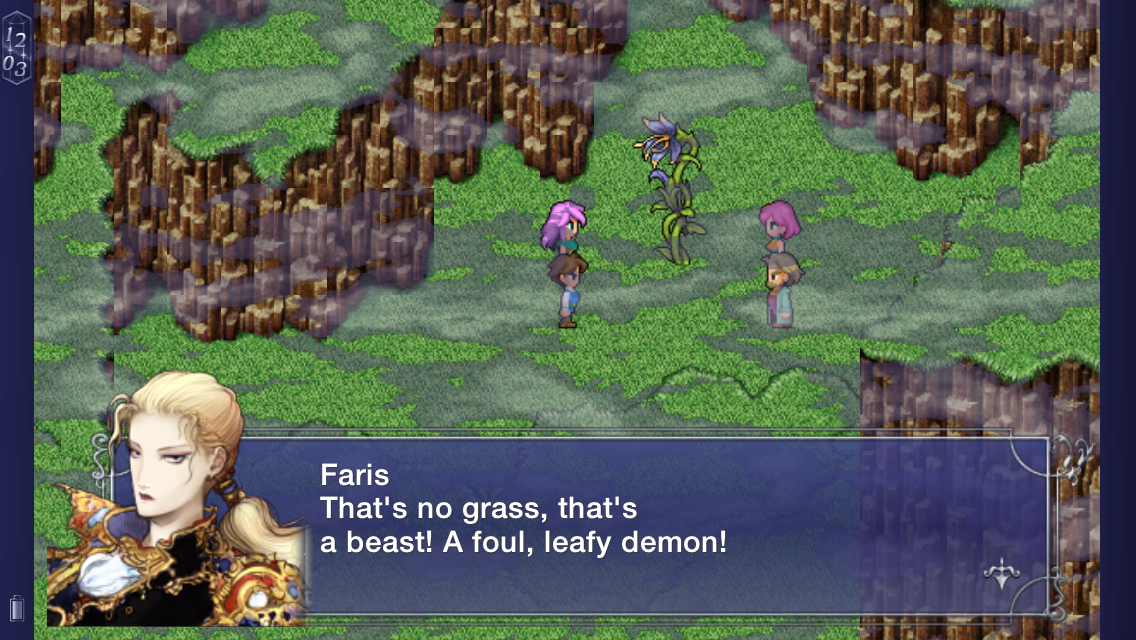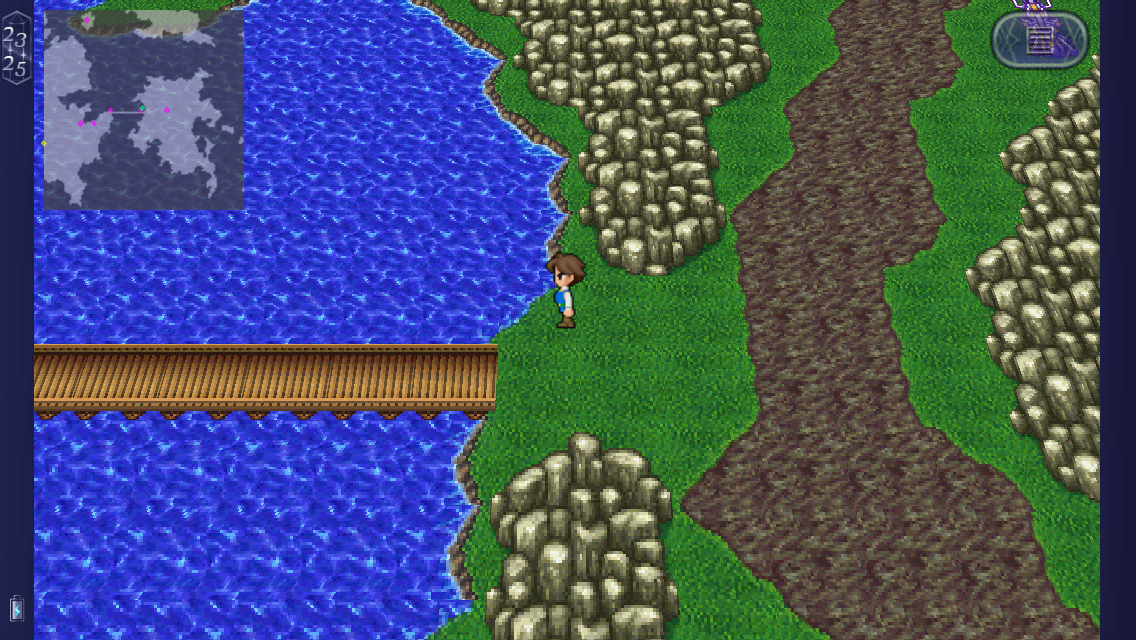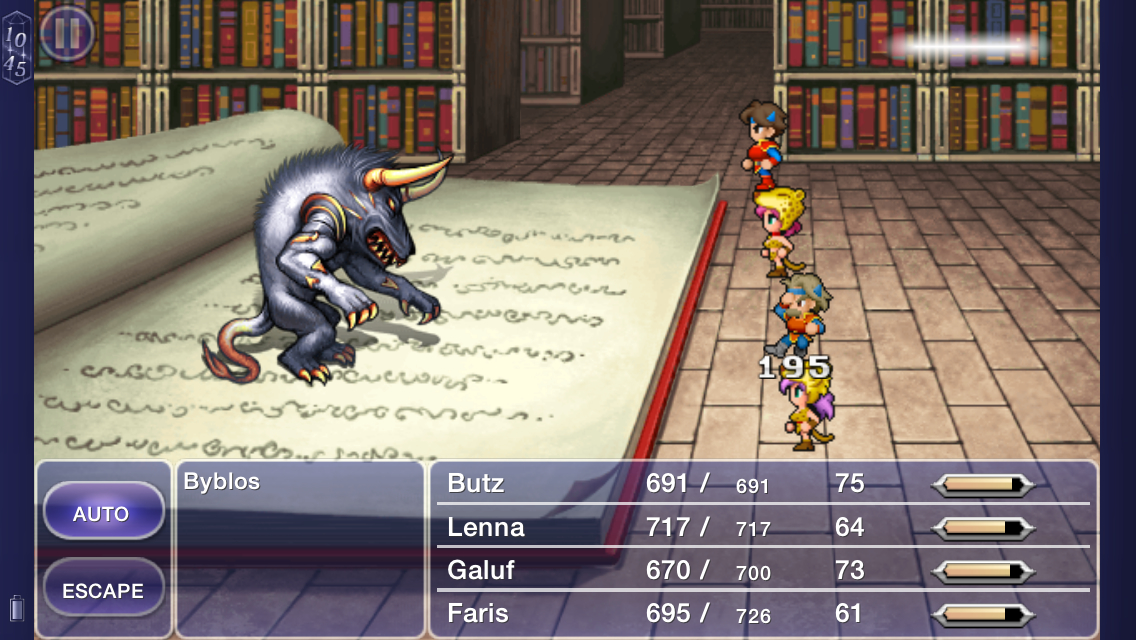 Hello, gentle readers, and welcome to the RPG Reload, the weekly feature where we appreciate the subtle pun of the root of all evil being a tree. Each week, we take a look at an RPG from the App Store’s past. It’s a chance to revisit old favorites, reflect on their place in the overall scheme of things, or just to take a deeper dive than our reviews typically allow for. I try to present a balanced schedule of RPGs from week to week, but if you have any suggestions, I’m certainly open to hearing them. Simply comment below, post in the Official RPG Reload Club thread in the forums, or tweet me at @RPGReload and let me know what you’d like to see featured. We’ve got one last normal reader’s choice article coming up in August, so get those suggestions in! Although I’ll be sad to see it go, I’m pretty excited to tell you about its replacement for the following month. I’ll be giving you all more details on that pretty soon.
Hello, gentle readers, and welcome to the RPG Reload, the weekly feature where we appreciate the subtle pun of the root of all evil being a tree. Each week, we take a look at an RPG from the App Store’s past. It’s a chance to revisit old favorites, reflect on their place in the overall scheme of things, or just to take a deeper dive than our reviews typically allow for. I try to present a balanced schedule of RPGs from week to week, but if you have any suggestions, I’m certainly open to hearing them. Simply comment below, post in the Official RPG Reload Club thread in the forums, or tweet me at @RPGReload and let me know what you’d like to see featured. We’ve got one last normal reader’s choice article coming up in August, so get those suggestions in! Although I’ll be sad to see it go, I’m pretty excited to tell you about its replacement for the following month. I’ll be giving you all more details on that pretty soon.
When I first started writing the RPG Reload, I planned on a few things. First, I knew I would be playing a lot of RPGs in a very short span of time. Many of them would be games I’d only played once or, in some rare cases, not at all. I also knew there were certain games I was itching to write about, but that I would have to space them out to act as tent poles, not so much for the popularity of the feature, but more for my own personal well-being. Guaranteed treats, if you will. This week’s game is perhaps the sweetest of those treats, as it’s one of my very favorite RPGs of all-time, a position not lightly earned. Today, I’m going to be talking about Final Fantasy 5 ($14.99), the most generally under-appreciated of the trio of 16-bit Final Fantasy games.
Of course, given the circumstances of its worldwide release, it’s little surprise that this particular installment is less popular among English players than its SNES peers. in Japan, it was just another release in a series that was rapidly picking up steam. Released in December of 1992, it would go on to sell 2.45 million copies in its home country, easily besting Final Fantasy 4 ($14.99) ‘s total of 1.44 million copies and coming in just under Final Fantasy 6 ($14.99) ‘s total of 2.55 million copies. It would be the last Final Fantasy game directed by series creator Hironobu Sakaguchi, who would move on to a producer role from the sixth installment. Given that, it’s perhaps no surprise that he names Final Fantasy 5 as one of his favorites. Series veterans like Yoshitaka Amano, Nobuo Uematsu, and Hiroyuki Ito would also return in their usual roles.
Notably, this entry marks two notable members joining the Final Fantasy team in significant roles. Tetsuya Nomura had done debugging work on Final Fantasy 4, but in this game he was promoted to designing most of the monsters, his first proper work on the series as an artist. He would assist with character design in the next game before taking over as the main artist on the series from Final Fantasy 7. Yoshinori Kitase had previously worked on Final Fantasy Adventure and Romancing SaGa, and his work on the scenario and event planning of Final Fantasy 5 would represent the beginning of a baton pass from Sakaguchi to Kitase. He would direct the next few installments of the series before taking over as producer and general guy in charge of the series, a position he occupies today. Given how dark Kitase’s Final Fantasy games would end up feeling, it’s interesting that his role for Final Fantasy 5 was largely to introduce some comic relief to what was kind of a downer story from Sakaguchi.
Outside of Japan, Final Fantasy 5 was anything but a normal installment. Though Final Fantasy 2 ($7.99) and Final Fantasy 3 ($14.99) had been passed over due to the late arrival of Final Fantasy 1 ($7.99) and the pending sales irrelevance of Nintendo’s 8-bit console, Final Fantasy 4 had been swiftly translated and released in the US as Final Fantasy 2. Initially, a similar plan was intended for Final Fantasy 5. A localization as Final Fantasy 3 was planned and work began on it soon after the Japanese release. It was around this time that Square decided Americans weren’t cut out for complicated RPGs just yet. It had been just enough time after the release of Final Fantasy Mystic Quest to gauge the results of that particular experiment. Worse yet, Final Fantasy 5 hadn’t been testing well with out-groups, according to a 1994 interview with translator Ted Woolsey. Square decided to shelf the release and grant the honor of the Final Fantasy 3 title to the more story-focused Final Fantasy 6. The next idea was to release the game as a distinct entry called Final Fantasy Extreme. Unfortunately, the timing never worked out for the SNES version of the game. From there, a developer named Top Dog Software was going to do a PC port of the game, but this too ended up canceled, as did a later Eidos attempt to bring it to PC.
Humorously, in hindsight anyway, a localization of the dreadful anime follow-up to the story would get an official release before the game did. Final Fantasy: Legend Of The Crystals takes place 200 years after the events of Final Fantasy 5 and follows descendents of the game as they seek to recover the crystals from a new evil. The entire series was four episodes and came on two VHS tapes. Though it was originally released in 1994 in Japan, it would later be released in English in 1998. Perhaps serving as a grim portent for future cross-media Final Fantasy offerings, it was pretty much dreadful. I’m pretty sure the entire thing is on YouTube these days if you feel like subjecting yourself to it. FF fans at the time were obsessed with Final Fantasy 7, so getting a years-old sequel to a game that hadn’t even been officially released outside Japan was a bittersweet premier for non-game Final Fantasy media. For patient English FF fans who had been waiting for any sort of release of Final Fantasy 5, it was almost cruel. Some particularly dedicated fans didn’t feel like waiting for Square to make a move, however.
There are many things Final Fantasy 5 is well-known for. Perhaps one of the most interesting of those is its English fan translation via romhacking. Done by RPGe and released in October 1998, it’s often described as the most famous fan translation of all-time. It was certainly one of the earliest RPG translations to be completed, as far as I can remember. SNES emulators were just starting to get up to speed, so to speak, so the timing was kind of perfect. As translations go, it was actually really good, if lacking in spice. At the very least, it was miles beyond the script found in the game’s first official English release, which would come a year later on PlayStation as part of the Final Fantasy Anthology. While the game ran fairly well compared to the dreadful PS1 version of Final Fantasy 6, the translation was clearly picked up and dusted off from the 1993 attempt. The PlayStation 1 localization can best be described with one word: “D’Arr!"
Final Fantasy 5, like most of the other early games, received a port to the Game Boy Advance. Released in late 2006, this is probably one of the better GBA versions of an FF game, and is considered by many to be the definitive version of the game. It included four new jobs and a new dungeon with a special boss that actually kind of fits in the story. Most importantly for English players, it also received a completely new localization. On the whole, it’s quite excellent. There are lots of stupid jokes, but they fit the game well, and Faris doesn’t speak with a weird Cornish pirate accent. It was hoped that a 3D DS remake in the lines of Final Fantasy 3 and Final Fantasy 4 would follow, but the somewhat disappointing sales of the latter combined with flagging DS software sales across the board effectively put an end to that idea. Instead, Matrix Software would go on to create an enhanced port of Final Fantasy 5 Advance to smartphones. It featured all of the content from that version, with completely redesigned graphics and a new user interface.
The new high resolution graphics met with what I’m going to generously describe as a mixed response. Although the sprites were designed by Kazuko Shibuya, the artist responsible for most of the 16-bit character sprites including FF5‘s, many fans took issue with the game’s slipshod visual coherency. Individual tiles were recreated in high resolution with seemingly little concern as to whether or not they would fit together anymore, a problem most notable on the somewhat complex designs of the meteors. Each little piece of the graphics looked very good, but when pieced together, well, it certainly revealed that each piece had been worked on in isolation, I’ll say that much. That all said, I like the new character sprites. They’re a lot more expressive than the originals, particularly outside of battles. Everything other than the visuals comes out great, and I especially appreciate the new auto-battle feature when I’m grinding job points. The mobile version of the game released on iOS in March of 2013 and on Android in September of that year, and that’s been the last peep out of Final Fantasy 5 since.
As for my history with the game, it’s been an interesting one. As a serious Final Fantasy nut, it always bothered me that there was this “lost" 16-bit Final Fantasy that I hadn’t played. So, I did what many probably did: I called the number in the back of my Electronic Gaming Monthly magazine and ordered the Japanese version of the game from DieHard Gamefan, along with an adapter. While it wasn’t the first Japanese-language game I had played, it was the first one that I actually needed to read. Being in a small Canadian town in the pre-Internet days, there was little chance of finding anyone or anything to help me translate. I dutifully tested each option, item, and ability, and recorded the results with my best approximation of the unfamiliar squiggles that were Japanese kana. This took an incredibly long time, as you might imagine, and the story was a bit hard to follow, but if nothing else, it was a very memorable experience, particularly in the greater context of where my life went.
I remember playing the game on an emulator with the English patch when that was released, with certain story points finally, after literal years, becoming clear. When the PlayStation version released, I bought that too, and cringed at the utterly horrible translation, though I enjoyed the game just the same. When the Game Boy Advance version came out, I was all over it, ignoring the recently-released 3D version of Final Fantasy 3 in favor of doing yet another run through Final Fantasy 5. Yet at this point, it was still far from my favorite in the series. That wouldn’t come until a few years later, when a poster on a message board I frequented presented a whole new way of playing the game, called the Four Job Fiesta.
Before I explain that, I should discuss the game’s merits. Of the three 16-bit Final Fantasy games, its story is probably the least dramatic, and in a series mostly known for stories, I think that’s a major reason why it turns people off. The funny thing is, the story is actually quite heavy in places, but there’s so much goofy humor sprinkled in that it’s tough to take things very seriously most of the time. One of my friends has maintained that the best way to enjoy the story is to imagine there’s a studio audience and a laugh track. I tend to agree with that. Characters will cheekily break the fourth wall here and there, puns and dad jokes abound, and there are absurd situations lurking around every corner. Hero Butz lacks the essential angst that pervades most Final Fantasy leads, but I find that appealing, to be honest. Still, if I were to rate the games based on story, I probably wouldn’t put Final Fantasy 5 very high on the list. It certainly has its moments, and one of its villains has become one of the better running gags in the series, but overall, it’s not something people will write a crown of sonnets about.
No, what brings people to Final Fantasy 5 is its gameplay, and in particular, its job system. While Final Fantasy 3 featured a somewhat similar system, and later games would also revisit the concept, I’m not sure any Final Fantasy nailed its job system as well as this one does. Each character starts the game as a freelancer, a sort of blank slate that can’t do a whole lot on its own. As you come across each of the four crystals in the first third of the game, you’ll unlock a few new jobs each time. The first crystal more or less gives you the classic jobs from the first game, with more powerful jobs coming as you progress. You can change jobs at any time with no penalty, and as you fight enemies using that job, you’ll earn points towards unlocking new abilities. You can assign any learned abilities to whatever open slots you might have. If you’re using a regular job, you can use one other ability, while if you’re using the freelancer or the mimic, you can use two. Mastering jobs, that is taking them to their maximum level, not only unlocks a powerful ability, but also grants a stat bonus that stacks on the freelancer job. Theoretically, if you master every job, your freelancers will be tiny gods, and that’s kind of fun.
It’s enjoyable and very easy to experiment with different combinations, but I think what really makes it is how well-balanced everything is. Oh, you’ll certainly have an easier time with particular bosses and situations if you’re packing the right jobs, but what’s truly remarkable is that you can still win using the wrong ones. That brings us back to the Four Job Fiesta. A set of special challenge rules cooked up by a man named Eric Koziol along with a speedrunning gaming dynamo known only as Red Scarlet, the Four Job Fiesta limits you to one job from each crystal. The job you get is randomly assigned, and you must have at least one party member using that job from the moment you get it. It started as a small thing for a few members, but over the years it has grown into a summer event for Final Fantasy fans. Better still, after a few years, it was transformed into a charity event, benefiting Child’s Play. I still remember joining in the first official charity version of the Four Job Fiesta, where perhaps several hundred dollars were raised by players. Glancing over at this year’s total, I can see that it’s sitting at $11,000 and counting. That’s a truly beautiful thing.
Final Fantasy games are not usually that difficult anymore. You certainly don’t have to use most of the tools they give you. The Four Job Fiesta changes that, especially if you get an odd party. Last year, I got White Mage, Berserker, Trainer, and Dancer. Healing was not an issue, but dealing damage certainly was. I couldn’t even use the Trainer to his best potential because the Berserker would inevitably hit my controlled monster, breaking my control. Still, I was able to beat the last boss thanks to a Dancing Dagger, a Lamia Tiara, and a bit of luck. This year, I seem to have the opposite problem. My jobs are Knight, Berserker, Ranger, and Dragoon. Can we rain devastation on the enemies? You bet. The best healing at my disposal is chugging potions or hoping for the Ranger to call on the right animal friend, though. Every year I play Final Fantasy 5, I get a slightly different party, and I’m forced to find new tricks that have me play the game a different way. And it all works. Somebody beat the game this year with a party of four Berserkers. Think about that one. Or how you can beat a magic-only boss when you don’t have any magic. Or how to deal enough damage to stay ahead of a boss with healing magic. But it’s all possible, and that shows what an excellently-designed game this is, in my opinion.
Now, it’s certainly possible to challenge run other Final Fantasy games, and some of them are very fun. But none of them offer the variety that Final Fantasy 5 does, making this easily the most replay-friendly installment in the series. I play this game from start to finish every single summer, and I come away from it each time appreciating it a little more. It’s through that process that the game has steadily climbed in my personal rankings of the series. I now consider it my favorite Final Fantasy game, and not by a small margin, either. I look forward to each journey I set out on with Butz, Lenna, Faris, and Galuf. I laugh and feel down at the same points in the story, while each time creating my own new stories out of the MacGyver-like solutions I need to find to overcome particular boss battles. And when the credits roll on each year’s ramshackle party, I feel a powerful sense of accomplishment at having outsmarted the game yet again.
If you’ve played Final Fantasy 5 before and liked it, but didn’t love it, I strongly urge you to try it again under Four Job Fiesta rules. It’s perhaps the best way to bring out the game’s strengths and reveal it for the masterpiece that it is. If you’re new to the game, I’m not sure if it’s the best way to experience it for the first time, though I know some people who have done that and had a good time. Personally, I think it’s better to get acquainted with the way you can combine the abilities of various jobs and have fun playing around in the sandbox before you impose limitations on yourself. Either way, don’t miss playing this game. I’d recommend the mobile version in a heartbeat, but if you have access to the GBA version, that’s another great way to enjoy it. That said, there aren’t any truly bad versions of the game, so play it however you can. Final Fantasy 5 might not play the same tune as most of the other Final Fantasy games, but its unique melody is just as wonderful.
The iOS version has had a number of updates since its initial release, including the addition of iCloud and MFi controller support. Since it’s a fairly recent release, it has had support for 4-inch iPhone screens and has been a universal app from the get-go. This being one of the core Final Fantasy games, I expect Square Enix to keep it running no matter what happens, though Final Fantasy 2‘s on-going issues certainly show us that they might not do much more than that. The game could also use an update for native iPhone 6 family support, something I imagine will come sooner or later given that the game supports a variety of screen sizes on Android.
If you’re the sort that only plays through RPGs once, Final Fantasy 5 is probably not going to be your favorite Final Fantasy game. If, on the other hand, you enjoy replaying them, this game is clearly among the best of the bunch. And this is the RPG Reload, after all, so you know which camp I fall into. It’s goofy, charming, long enough to feel big without overstaying its welcome, has as deep gameplay as you’re going to find in the main series, and all that great music is just gravy on top. I’m not sure if modern Square has it in them to make something quite like this anymore, but the awesome thing about Final Fantasy 5 is that they don’t have to.
That’s just my take on Final Fantasy 5, though. What do you guys think? Are any of you participating in the Four Job Fiesta? What are your favorite job classes? These are all questions I’d like to hear some answers to, so do me a favor and leave your thoughts in the comments below, in the Official RPG Reload Club thread, or in a tweet to @RPGReload. We’ll be talking about this game on the RPG Reload Podcast in early August, so if you have any questions about it or any other RPG, you can send those to [email protected] and we’ll answer them on the show. As for me, I’ll be back next week with another RPG. Thanks for reading!
Next Week’s Reload: Rogue Touch ($2.99)
